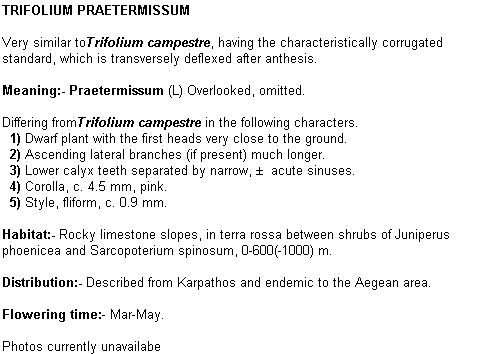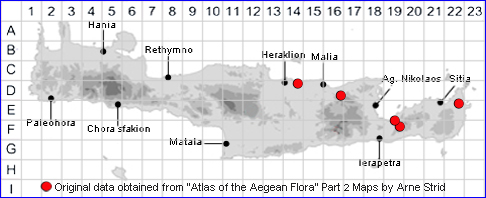
SPECIES DESCRIPTION
TRIFOLIUM CAMPESTRE
Including: Trifolium praetermissum
Family and Genus:- See- LEGUMINOSAE/Subgen. LOTOIDES/Sect.
Common Names:- Hop trefoil
Homotypic Synonyms:- Amarenus campestris, Chrysaspis campestris,
Trifolium procumbens subsp. campestre, Trifolium procumbens var.
campestre.
Meaning:- Trifolium (L) With three leaflets.
Campestre (L) Of the pasture, from flat land, of plains.
General description:- Low to short, hairy annual.
Stems:-
1) Up to 30(-50) cm, hairy, erect or ascending.
Leaves:-
1) Leaflets, 8-10 mm, obovate, the terminal one petiolulate.
2) Stipules, semiovate, dilated and rounded at the base.
Flowers:-
1) Heads, up to 15 mm, dense, 20- to 30-flowered.
2) Pedicels, ½ as long as the calyx-tube.
3) Calyx teeth,
a) upper, as long as or shorter than the upper limb of the calyx-tube.
b) Lower, 1-2 times as long as the lower limb of the calyx-tube.
5) Corolla, (3-)4-5(-6) mm, yellow,
a) standard, limb broadly cochleate or if small sulcate.
Fruit:-
1) Legume, 3-6 times as long as the style, with only one seed.
Key features:-
1) Corolla, (3-)4-5(-6) mm (if less, then markedly sulcate)
2) Legume, 3-6 times as long as the style.
Habitat:- Dry open shrubby vegetation, open coniferous woodland and in a wide
variety of disturbed habitats, generally 0-800(-1600) m.
Distribution:- Common throughout Greece. - Widespread in Europe and SW Asia
Widespread and common on Crete.
Flowering time:- Mar-May.
Photos by:- Steve Lenton


~~~~~~~~~~~~~~~~~~~~~~~~~~~~~~~~~~~~~~~~~~~~~~~~~~~~~~~~

